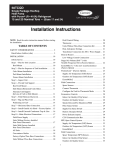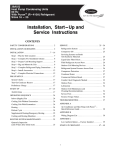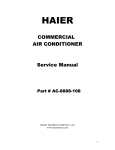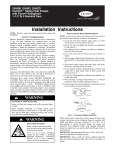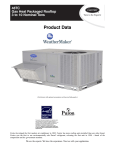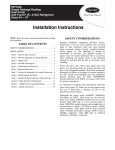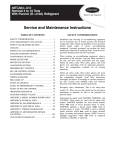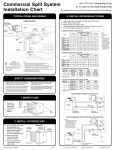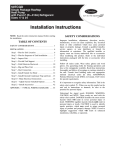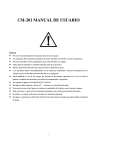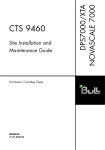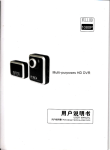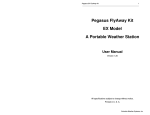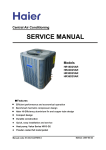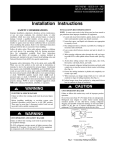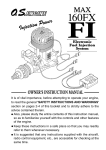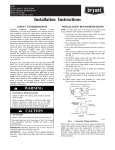Download Safety
Transcript
Safety Always observe the Manufacturers Safety Precautions and Warning Tags • Read and follow all safety instructions given in the manufacturer's installation instructions. • Always turn off the main power to a system before making any repairs. There may be more than one disconnect switch. If applicable, turn off the accessory power. • Tag and lock out all disconnect switches. Safety Always observe the Manufacturers Safety Precautions and Warning Tags • Always remove rings, watches, and other jewelry to lesson the chance of electrical shock. • When taking voltage or continuity measurements on a compressor in a pressurized system, do not take the measurement directly at the compressor terminals. – Disconnect the compressor leads at the contactor to take the measurements. Noise Complaints INSTALLATION RECOMMENDATIONS NOTE: In some cases noise in the living area has been traced to gas pulsations from improper installation of equipment. 1. Locate unit away from windows, patios, decks, etc. where unit operation sound may disturb customer. 2. Ensure that vapor and liquid tube diameters are appropriate for unit capacity. 3. Run refrigerant tubes as directly as possible by avoiding unnecessary turns and bends. 4. Leave some slack between structure and unit to absorb vibration. 5. When passing refrigerant tubes through the wall, seal opening with RTV or other pliable silicon-based caulk. (See Fig. 1.) 6. Avoid direct tubing contact with water pipes, duct work, floor joists, wall studs, floors, and walls. 7. Do not suspend refrigerant tubing from joists and studs with a rigid wire or strap which comes in direct contact with tubing. (See Fig. 1.) 8. Ensure that tubing insulation is pliable and completely surrounds vapor tube. 9. When necessary, use hanger straps which are 1 in. wide and conform to shape of tubing insulation. (See Fig. 1.) 10. Isolate hanger straps from insulation by using metal sleeves bent to conform to shape of insulation. Noise Complaints • Operational vibration could indicate a charge issue. • Verify charge and ensure proper piping and structural penetration insulation. • Tubing that is too rigid to building rafters without proper insulation could transfer noise throughout the structure. • On some occasions a sound dampener or mass weight (RCD part no. 328209--751) placed on the vibrating tubing has been known to reduce this noise. • Utilizing compressor split post grommets (see Fig) may also reduce this vibration if piping cannot be remedied. Split Post Grommet part number: KA75UG100 Noise Complaints • An operational high pitch frequency or “waa waa” sound that appears to resonate through the suction line could indicate a need to add more flex or muffling in the lines. • This has been occasional in scroll compressor applications and is usually remedied by adding a field--fabricated suction line loop. • Reciprocating compressors may have a noticeable discharge pulsation that could be remedied with a field installed discharge muffler. • Recommend loop by continuous tubing with no more than 12 inches vertical and 6 inch horizontal loop. Noise Complaints Enable Quiet Shift or (for lower tier equipment) upgrade the defrost board to one that has the Quiet Shift feature. Quiet Shift Upgrade document to help with the process. Once Quiet Shift is enabled the compressor will stop for 30 seconds at defrost initiation and termination to prevent this noise. If defrost board is upgraded, please send me or your TM the complete model and serial so I can report it Quiet Shift Upgrade.pdf Noise Complaints • Nuisance “moose call” noise from HP going in/out of defrost. • Part number EF17BZ251 • Field Solution • Replace With • EF17BZ252 – Developing repeatable test to replicate the noise, each and every time – Supplier of reversing valve has visited and verified the noise. – Working to isolate the root cause of the moose call from a component to system solution. – Issue appears to be a flow related noise that occurs after the mid point of the shift coming out of defrost. Reversing Valve Troubleshooting Light Commercial Split A Bi-Flow kit must be added to the LLSV to convert them to heat pump operation. Ordering Number Liquid Line Size Mfg Part Number Used on Sight Glass EF680033 3/8” ALC-066208 AUQ07, 575Jx07, CHS07 HMI-1TT3 EF680034 1/2” ALC066209 AUQ08-12, 575Jx08-12, CHS091-121 HMI-1TT4 EF680037 Solenoid Coil Assy AMG-24/5060 All units EF680039 Bi-Flow Kit ALC066224 All Heat Pumps SuperHeat Normal / 5-20˚ 10psig = 4.3˚ (average based on SST range/29.5˚-55.1˚) Fitting Losses Outdoor Heat Pump - Piston Resizing 12 Outdoor Heat Pump Unit - Piston Resizing 13 Fault Code Review Fault Code Review Using Nitrogen Is Not Optional •Use of nitrogen during brazing Carbon deposits resulting from not using nitrogen during brazing 16 Brazing • Purge with nitrogen while brazing • Nitrogen prevents carbon that can be washed with POE oil and can cause restrictions and oil decomposition 17 Part# UNF3 / $55.00 FB4CNF018-060 & piston use DSB 10-0008 provides most of the information needed to answerer these questions. DSB 10-0008.pdf This document is the highlight slide from the Spring Update class on the FB4C. FB4 Update Class Slide.pdf Picture examples of the indoor (cooling) and outdoor (heating) pistons. Notice the note on the bottom of slide 1 (You may use FB4C’s as a R-22 fan coil replacement by removing the R410a piston and re-installing the R-22 piston that was in the old Carrier, Bryant or Payne fan coil.) FB4C_Piston Models.pdf FB4CNF018-060 & piston use Current Super Heat chart for use with a cooling piston as the older slide charts are not compatible with the current product. New_HP_Superh eat_Chart.doc Part number and drill size of old style and new style pistons Piston_Models.xls Additional outdoor units (including piston size) approved to be used with the FB4C, with a piston, since the release of DSB10-0008. Pistons by model_05_08_2010.xl... Remember to always check PD for proper matches and ratings. Furnace Coil Conversion Furnace Coil Conversion Convert a current production 410A furnace coil back to R22 in order to satisfy a customers in warranty request. Action: Reuse the old piston that was in the original R22 evaporator coil. Solder the equalizer tube closed at the suction header tube. RCD part numbers : Description Usage location 324177-701 Adapter Assembly 318289-301 Tube / Body Coupling Adapter Attach to the new 410A distributor assembly Body to hold the piston 311682-201 Adapter Piston retainer & liquid line connection Furnace Coil Conversion Useful Service Manuals Residential Residential 2009 Piping - Long... Fan Coil Service Manual 6sm.pd... Mobile Home HP-AC Small Packag... Light Commercial 48TC 15-25 Ton Service Manual.... 50TC 3-10 Ton Service Manual.p... 50TCQ 3-8.5 Ton Service Manual... Res Split HP-AC Service Manual... Review Tips / Low Voltage Multi-Voltage Transformer Check to see that the Control Transformer Primary Connection is tapped for the correct voltage When tapped for the wrong primary: Secondary voltage and / or Current will be effected! Tips / Low Voltage Total Available Amp Draw Of a Circuit = SECONDARY VOLTAGE VOLT AMPS Volt Amps Secondary Voltage 75 V.A. 24 VAC = 3.125 Amps Actual operating VAC will be more accurate. Tattle Tales • Parts to make your own can be purchased at Radio Shack – 1 ¼” X ¼” in-line fuse holder – 1 ¼” X ¼” glass fuse • Measure the circuit current to determine fuse size Tips / Air, Acid, & Moisture Vacuum Pump Maintenance • The oil used in a vacuum pump can quickly become contaminated. On average it should be changed after every 10 hours of operation or immediately after evacuating a wet or contaminated system. • All quality vacuum pumps have a gas ballast that should be opened during the early stages of an evacuation. Tips / Charging Techniques Weigh in Method When can you use this method? Anytime What is the unit charged for from the factory? 15 feet How much do you add per foot of line set? .6 oz/ft Note: 16 oz/lb Note: You must be using the standard line set size for the unit and not have greater than 80 ft EL of tubing. Otherwise this method will not be accurate. Example: You have unit with 60 ft of line set (assume proper diameters). How much charge should be added? 60 ft – 15 ft = 45 ft 45 ft x .6 oz/ft = 27 oz. 27oz. X 1 lb/16oz. = 1.69 lbs Tips / Charging Techniques Sub Cooling Method When can you use this method? • When using a TXV • OD amb between 70 and 100 F • ID amb between 70 and 80 F Important Steps • Must let unit run for 15 mins minimum • Charge must be added in short cycle intervals. Opening of valve Assume constant OD temp Unit will be under charged in this region 60 F Unit will be over charged in this region 70 F 80 F ID Ambient 90 F Fan Coil Conversion Don’t forget the Drain Pan Support Bracket Duct Sweating -First we need to understand the problem!! -To resolve sweating we must understand how to evaluate the problem. Dew Point – Dew Point is the temperature at which condensation forms. When air comes in contact with a surface that is at or below its Dew Point temperature, condensation will form on that surface. – Dew Point calculation? Duct Sweating – All this means is that if condensation is forming, the surface on which it is forming is below Dew Point. – To prevent the condensation, the surface must be above Dew Point – Dew Point in a attic can easily be above 80° – Can the insulation surface temperature be below 80°? YES!! Dew Point & Relative Humidity 130 grains/pound DP can be constant while RH changes 121 Degrees 130 grains/pound 97 Degrees 130 grains/pound 75 Degrees DP=74° DP=74° DP=74° 100 RH 50% RH 25% RH Inside structure Outside In Attic Duct Sweating Dew Point Table % Relative Humidity Air Temp °F 110 105 100 95 90 85 80 75 70 65 60 55 50 45 40 35 32 100 95 90 85 80 75 70 65 60 55 50 45 40 35 30 110 108 106 104 102 100 98 95 93 90 87 84 80 76 72 105 103 101 99 97 95 93 91 88 85 83 80 76 72 67 100 99 97 95 93 91 89 86 84 81 78 75 71 67 63 95 93 92 90 88 86 84 81 79 76 73 70 67 63 59 90 88 87 85 83 81 79 76 74 71 68 65 62 59 54 85 83 81 80 78 76 74 72 69 67 64 61 58 54 50 80 78 77 75 73 71 69 67 65 62 59 56 53 50 45 75 73 72 70 68 66 64 62 60 58 55 52 49 45 41 70 68 67 65 63 61 59 57 55 53 50 47 44 40 37 65 63 62 60 59 57 55 53 50 48 45 42 40 36 32 60 58 57 55 53 52 50 48 45 43 41 38 35 32 55 53 52 50 49 47 45 43 40 38 36 33 32 50 48 46 45 44 42 40 38 36 34 32 45 43 42 40 39 37 35 33 32 40 39 37 35 34 32 35 34 32 32 25 65 62 58 54 49 45 40 36 32 20 60 55 52 48 43 38 35 32 15 51 47 44 40 36 32 32 10 41 37 32 32 32 Insulation required to prevent condensation Possible contributing factors • Low airflow / causes a cold coil and Low SAT – Zoning bypass open for long periods can cause the same • Low insulation R-value – – – – – Wet insulation Wrap not properly installed / to tight Wrap the supply plenum and add duct liner Wrap the fan/coil Use mesh hanging material under duct wrap and seal penetration with mastic – Hanging duct helps with evaporation and insulation compression • If attic temp is high and RH is low, evaporation helps prevent duct sweating – Install duct wrap over damper actuators Possible contributing factors • Leaking duct – Air leaks in the SA will cause the insulation to be well below DP • Extremely high Dew Point / Look for possible contributors: – Power Attic Ventilators / Disable them – PAV’s introduce more moisture into the attic and keep it cooler causing a higher RH and less evaporation. PAV’s generally cause moisture infiltration into the conditioned space. Sweating Bottom Line – Hotter is better. The hotter the attic, the warmer the surface temperatures and the lower the RH. • Warmer surface temperatures – less likely to be below Dew Point • Lower RH – Better chance for condensation to evaporate. • Hanging duct helps, so don’t lay it on the attic floor! Problems When Resizing Equipment • Customer perceptions—“Why do I have 3 tons when my neighbor has 5 tons?” Opportunity Explain longer run cycle = better life, efficiency, and humidity control @ a higher set point • Customer complaint—“Why is my equipment running so long? Its never done that before.” Must be explained Pre-sale • Greater vulnerability to poorly installed systems - duct leakage, improper refrigerant charge, or low airflow. • Higher recovery times from deep setbacks - instruct customers to “set & forget” thermostats. Correct equipment selection Higher Seer upgrade – more than just an efficiency change. Higher SEER, non variable speed fan/coils have a reduced latent capacity when compared to a less efficient system. (bigger-warmer evap coil) •Variable speed has a fan on delay •Infinity / Evolution has a reduced fan speed for the first 10 minutes of operation and no fan off delay in the cooling mode •Two stage equipment will have a much longer run cycle than single stage On average it takes a 13 SEER system 10–15 minutes to obtain full latent capacity, Compared to 5-7 minutes for a 10SEER system No load humidity control • Supplemental dehumidification system – Used to control indoor humidity when there is no sensible load. • Cool, cloudy, and/or rainy days. Also at night. – A better option than lowering the cooling set point • This will actually raise the RH and cause possible condensation of the structure










































